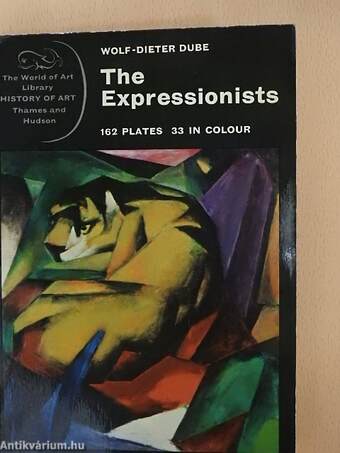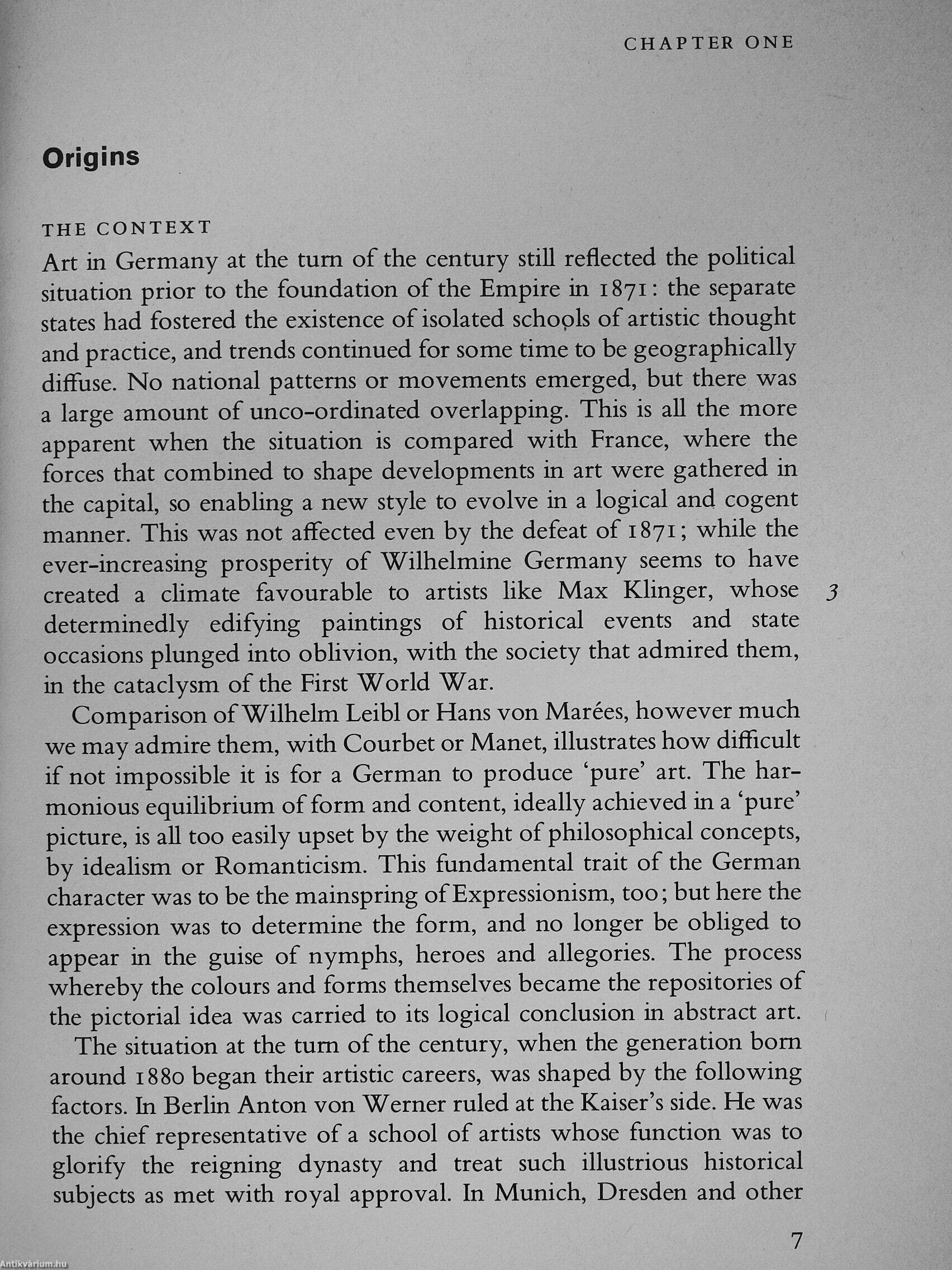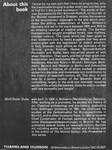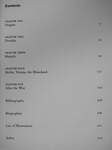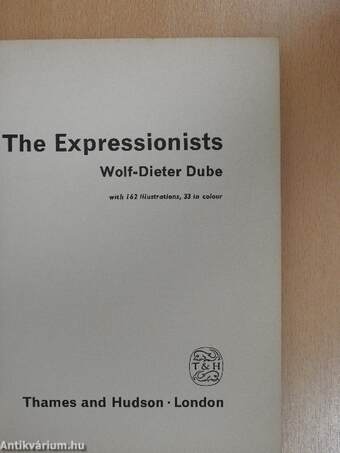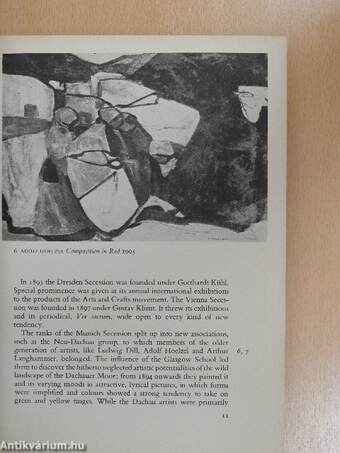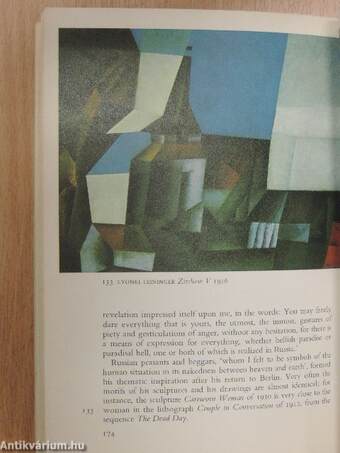1.067.339
kiadvánnyal nyújtjuk Magyarország legnagyobb antikvár könyv-kínálatát

VISSZA
A TETEJÉRE
JAVASLATOKÉszre-
vételek
The Expressionists
| Kiadó: | Thames and Hudson Ltd. |
|---|---|
| Kiadás helye: | New York |
| Kiadás éve: | |
| Kötés típusa: | Ragasztott papírkötés |
| Oldalszám: | 215 oldal |
| Sorozatcím: | The World of Art Library-History of Art |
| Kötetszám: | |
| Nyelv: | Angol |
| Méret: | 21 cm x 15 cm |
| ISBN: | 0-500-20123-4 |
| Megjegyzés: | Fekete-fehér és színes reprodukciókkal. |
naponta értesítjük a beérkező friss
kiadványokról
naponta értesítjük a beérkező friss
kiadványokról
Előszó
TovábbFülszöveg
AbOllt this 'I know for my own part that I have no programme, only • the inexplicable ionging to grasp what I see and feel, and DOOK to find for it the purest expression.' The words of German Expressionist Karl Schmidt-Rottluff, co-founder of the 'Brücke' movement in Dresden, convey the essence of the revolutionary movement in the arts which overthrew the stifling academicism of Kaiser Wilhelm's Germany and led in the years between 1900 and 1914 to an amazing upsurge of creative activity. The German Expressionists sought simplified forms, new rhythms, intenser colours. The name which has been given to their movement (not by them) suggests that they were preoccupied with the expression of violent emotion; in fact, however, such artists as the members of the 'Brücke' group, Kirchner, Heckel, Schmidt-Rottluff, Pechstein and Nolde, were concerned above all with sheer liberation. Their work, and that of their great contemporaries and associates-Marc, Macke, Jawlensky, Kan'dinsky, Klee... Tovább
Fülszöveg
AbOllt this 'I know for my own part that I have no programme, only • the inexplicable ionging to grasp what I see and feel, and DOOK to find for it the purest expression.' The words of German Expressionist Karl Schmidt-Rottluff, co-founder of the 'Brücke' movement in Dresden, convey the essence of the revolutionary movement in the arts which overthrew the stifling academicism of Kaiser Wilhelm's Germany and led in the years between 1900 and 1914 to an amazing upsurge of creative activity. The German Expressionists sought simplified forms, new rhythms, intenser colours. The name which has been given to their movement (not by them) suggests that they were preoccupied with the expression of violent emotion; in fact, however, such artists as the members of the 'Brücke' group, Kirchner, Heckel, Schmidt-Rottluff, Pechstein and Nolde, were concerned above all with sheer liberation. Their work, and that of their great contemporaries and associates-Marc, Macke, Jawlensky, Kan'dinsky, Klee and Kubin in Munich; Feininger, Beck-mann, Barlach and Meidner in Berlin; and Kokoschka and Schiele in Vienna, all of whom worked in related styles-is a decisive and immensely rich contribution to the history of twentieth-century art. The story is told here by a senior curator of the Bavarian State art collections, largely in the vivid and intensely revealing words of the artists themselves; these he sets in context with rare sympathy and insight.
Wolf-Dieter Dube was born in 1934 in Schwerin (Mecklenburg), Germany.
After working as a journalist, he studied the history of art, Classical archaeology and pre-history, graduating from Göttingen University in 1961. He continued his studies at the Zentralinstitut für Kunstgeschichte in Munich, and in other museums there. In 1965 he became Chief Conservator of Flemish paintings at the Bayerische Staatsgemäldesammlungen in Munich. He has published several books on twentieth-century German art, including works on Erich Heckel and Kirchner, and is the author of The Munich Gallery. Alte Pinakothek in this series.
THAMES AND HUDSON 30 Bloomsbury Street London WC1B3QP Vissza
Témakörök
- Idegennyelv > Idegennyelvű könyvek > Angol > Művészetek > Festészet
- Művészetek > Festészet > Korszakok, stílusok > XX. század > Avantgárd > Expresszionizmus
- Művészetek > Festészet > Idegen nyelv > Angol
- Művészetek > Festészet > Tanulmányok, összefoglalók > Külföldi
- Művészetek > Festészet > Általános festészet > Története
Wolf-Dieter Dube
Wolf-Dieter Dube műveinek az Antikvarium.hu-n kapható vagy előjegyezhető listáját itt tekintheti meg: Wolf-Dieter Dube könyvek, művekMegvásárolható példányok
Nincs megvásárolható példány
A könyv összes megrendelhető példánya elfogyott. Ha kívánja, előjegyezheti a könyvet, és amint a könyv egy újabb példánya elérhető lesz, értesítjük.



